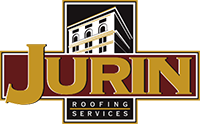D.I.Y. …R.? How to Correctly Replace a Roof Shingle
So you’re probably wondering what’s with the R? We all know what D.I.Y. is but do you D.I.Y.R.? There’s doing it yourself and then there’s doing it yourself the RIGHT way! We all like to do a little D.I.Y. when possible, if not only to save some cash and time but just for the pride of doing it yourself! However if you D.I.Y. wrong you could end up just paying more in the long run.
That’s why Jurin Roofing Services decided to do a series of roofing D.I.Y.’s to help the do-it-yourselfers out there make repairs to their roof system correctly. The first up in our new series…How to correctly replace an asphalt roof shingle. Stay tuned for more great D.I.Y. tips this summer!

Tools, Materials and Skills Required
The projects that turn out the best are normally those that you are best prepared for. Repairs to an asphalt shingle roof system require proper preparation for safety and completion of the repair. The following tools, materials and skills are suggested for completion of a quality repair.
Tools:
Materials:
Skills:
Step One – Safety First!
The most important aspect of making repairs to your asphalt shingle roof is to complete the repairs in a manner that keeps you safe. Remember that when working on your roof system you are working at elevated heights on roof slopes that may impact your ability to walk safely. If you are in doubt about your ability to safely complete the repair, please contact a roofing professional to complete the repair work for you.
The first step in making a repair to your asphalt shingle roof system is to setup your ladder and surrounding area to create a safe work zone. Set your ladder up so that it maintains a 4:1 ratio in the angle of the ladder. Make sure that the ladder has firm footing and if necessary have someone foot the base of the ladder to prevent it from slipping out.

In addition, if you are using an aluminum ladder make sure that you are not setting up the ladder near any power lines entering the home. Finally make sure that the ladder is tied off to the home and that the ladder extends a minimum of 3 feet above the roof edge.
Step Two – Remove the Damaged Shingle(s)
Very rarely do damages occur that remove the entire shingle and the nails. As a result, you need to remove the damaged shingle and the nails around the shingle to allow for the installation of the repair material.
The first part of preparing the roof shingles for removal is to break the sealant strips from around the area to be repaired. To do this, take the flat pry bar and slide it up and under the bottom edge of the shingle with gentle pressure to break the sealant strip free.
After the sealant strip has been separated the nails must be removed. Remember that you must remove the nails not only from the shingle that has been damaged and is being replaced, but also from the surrounding shingles to allow the new shingle to slide into place. Utilize the flat pry bar and access the nails from under the shingle that it penetrates.

Step Three – Install Replacement Shingles
After the original shingle and the nails have been removed you must assess the area. If the deck or underlayment felt paper has been damaged it is recommended that these layers be repaired before installing new asphalt shingles.
In order to repair the roof deck, you need to remove a sufficient amount of the shingles and underlayment to expose the surface of the plywood that spans a minimum of two rafters. You must remove enough decking to allow a new piece of roof deck to attach to a minimum of two rafters. After the deteriorated deck has been removed, you will install a new piece of deck that is comparable in thickness to the existing roof deck. The installer will then attach the decking to the rafters using a nail or screw type fastener that provides sufficient penetration to secure the new deck to the rafters.

After the deck has been repaired as necessary, the installer will overlay the new deck with new underlayment. The underlayment will be required to meet building code requirements. Building code may require asphalt impregnated felt paper or a self-adhering ice and water shield depending upon the location of the building. The underlayment may be attached to the roof deck using staples or roofing nails.
After installing the underlayment, you may install the repair shingles. It may be necessary to cut the repair shingles to size if the damaged shingles were not full size. Once the shingle has been cut to fit and laid in place, attach the shingles with the roofing nails. Make an effort to avoid nailing the shingle into the same hole that the prior shingle was nailed into. Review the material wrapper for the shingles to determine the required nailing pattern for the shingles. Remember to refasten the surrounding shingles where you may have removed nails to install the repair shingle.

The final step is to insert a small bead of asphalt mastic below the tabs of the shingles for the new repair shingle as well as any other areas where the shingles were loosened. This mastic provides some attachment in lieu of the sealant strip.






